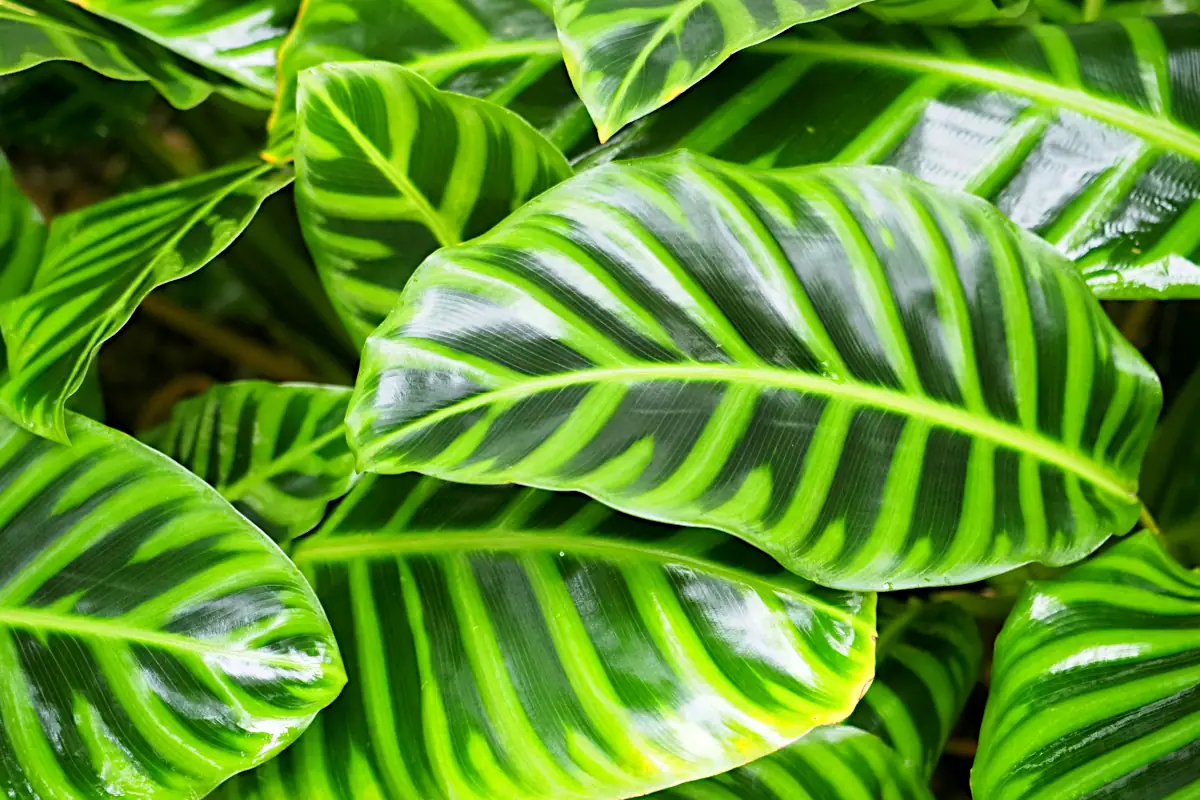The calathea plant is one of the most stunning tropical houseplants you can grow indoors. Known for its bold leaf patterns and movement that mimics prayer, it’s a favorite among houseplant lovers. Whether you’re interested in the ever-popular calathea orbifolia or the eye-catching calathea white fusion, learning how to properly care for these beauties is essential.
In this guide, we explore popular varieties, offer care tips, and tackle common issues — plus clear up confusion around the misspelled term “calathey.”
Table of Contents
- What is a Calathea Plant?
- Plant Profile
- Calathea Plant Care Tips
- Did You Know?
- Common Problems and Solutions
- Calathea Plant Selection Guide
- FAQs about Calathea Plant
- Final Thoughts on Calathea Plant
What is a Calathea Plant?
A calathea plant refers to a group of tropical, foliage-forward plants prized for their decorative leaves and indoor-friendly growth habits. Native to the rainforests of South America, these plants are part of the Marantaceae family. You might also see some varieties now classified under the genus Goeppertia, but they’re still commonly known as Calatheas.
Varieties like the rattle snake plant (Calathea lancifolia) or calathea makoyana (aka peacock plant) showcase vibrant, patterned leaves that fold up at night — a movement that’s earned them the nickname “prayer plants.” Don’t be surprised if you’ve seen people online search for “calathey” — it’s a common misspelling of calathea and doesn’t refer to a different plant.
Plant Profile
| Feature | Details |
|---|---|
| Scientific Name | Goeppertia spp. (formerly Calathea spp.) |
| Common Name(s) | Calathea, Prayer Plant, Rattle Snake Plant |
| Plant Type | Tropical perennial, indoor foliage plant |
| Best Climate / USDA Zones | 10–12 (indoors elsewhere) (What are USDA zones?) |
| Preferred Light Conditions | Bright, indirect light |
| Watering Needs | Keep soil consistently moist, not soggy |
| Soil Type | Well-draining, peat-based potting mix |
| Pet Safe or Toxic | Non-toxic to cats and dogs |
| Common Issues | Leaf curling, brown edges, spider mites |
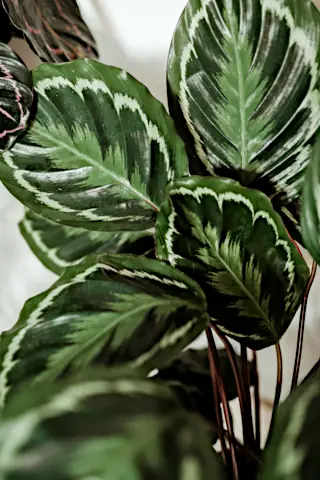
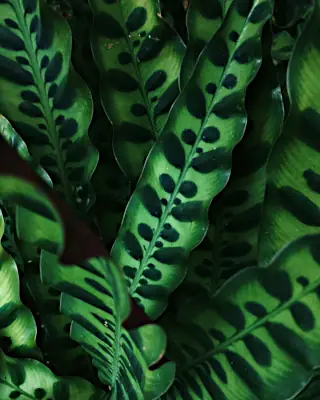
Calathea Plant Care Tips
Caring for a calathea plant requires some attention to detail, but the reward is lush, vibrant foliage that brightens any room. Here are essential tips:
- Light: Keep your calathea in bright, indirect sunlight. Direct sun can scorch the leaves, especially on sensitive types like calathea white fusion.
- Watering: Use filtered or distilled water. Tap water with chlorine or fluoride can damage the leaves.
- Humidity: Calatheas crave humidity. Mist regularly or place near a humidifier.
- Soil: Choose a rich, well-draining mix. A blend of peat, perlite, and coco coir works well.
- Temperature: Maintain a steady indoor temperature between 65–80°F (18–27°C).
- Fertilizer: Feed monthly in spring and summer with a diluted liquid houseplant fertilizer.
Popular varieties such as calathea orbifolia, calathea ornata, and calathea makoyana have slightly different tolerances, so it helps to learn about your specific plant.
Did You Know?
- The calathea plant is often called a “prayer plant” because its leaves raise at night, a process called nyctinasty.
- Calatheas are non-toxic to pets, making them ideal for homes with curious cats or dogs.
- The calathea white fusion is one of the most difficult but rewarding varieties to grow — its variegated leaves can be spectacular with the right care.
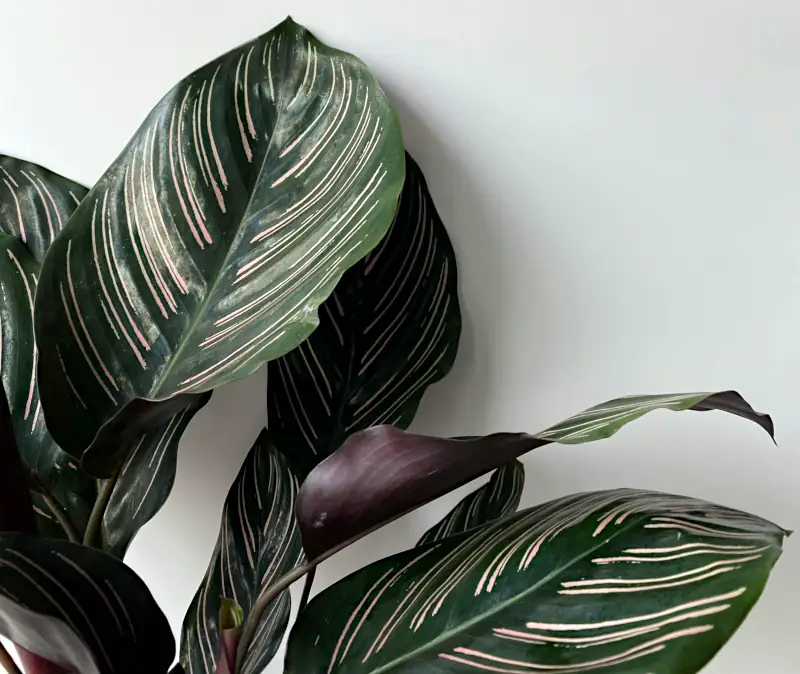
Common Problems and Solutions
Even experienced plant owners can struggle with calatheas. Here’s how to fix common problems:
- Brown leaf edges: Usually caused by dry air or chemicals in tap water. Use distilled water and increase humidity.
- Curling leaves: A sign of underwatering or low humidity. Water more frequently and mist the leaves.
- Yellowing leaves: Could indicate overwatering. Check for root rot and improve drainage.
- Pests: Spider mites are common. Wipe leaves with neem oil or insecticidal soap weekly.
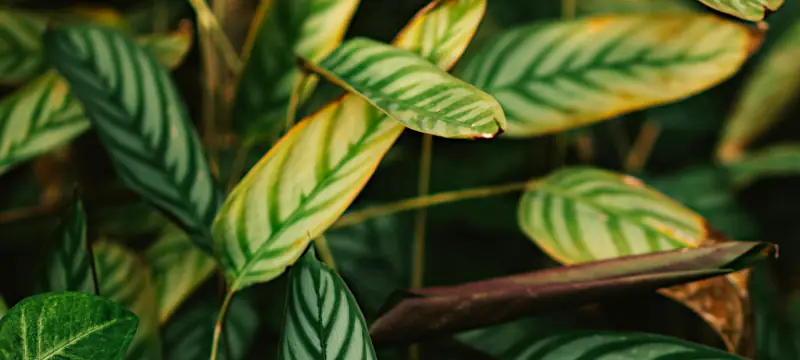
Calathea Plant Selection Guide
With over 300 known species and cultivars, selecting the perfect calathea plant for your home can feel overwhelming. Each variety showcases unique leaf patterns, colors, and growth habits — and some are easier to grow than others. Whether you’re a beginner looking for a forgiving plant or an experienced plant owner ready for a challenge, there’s a calathea variety for you.
When choosing a calathea, consider:
- Your environment: Some types are highly sensitive to humidity and temperature fluctuations.
- Lighting conditions: While all calatheas prefer indirect light, certain varieties fade more quickly in low light.
- Aesthetic preference: From striped leaves to marbled variegation, each calathea has a distinct visual personality.
- Care level: Some varieties like calathea orbifolia are more tolerant of imperfections, while others like calathea white fusion are divas in disguise.
Below is a comparison table of popular calathea varieties to help you decide which one is right for your space.
Calathea Variety Comparison Table
The Difficulty column in the table below indicates how challenging each variety is to grow and care for.
| Variety Name | Also Known As | Difficulty | Comments |
|---|---|---|---|
| Calathea orbifolia | — | Moderate | Large, round silver-striped leaves. One of the most popular calatheas. |
| Calathea ornata | Pinstripe Calathea | Moderate | Glossy dark green leaves with pink pinstripes. Stunning contrast. |
| Calathea lancifolia | Rattle Snake Plant | Easy | Narrow, wavy leaves with purple undersides. Great for beginners. |
| Calathea makoyana | Peacock Plant | Moderate | Feather-like markings resembling a peacock’s tail. Very decorative. |
| Calathea white fusion | — | Difficult | White, green, and purple variegated leaves. High humidity essential. |
| Calathea roseopicta | Rose-Painted Calathea | Moderate | Broad leaves with pink or red-hued center markings. Eye-catching. |
| Calathea zebrina | Zebra Plant | Easy | Velvety leaves with striped light and dark green patterns. Hardy choice. |
| Calathea medallion | — | Moderate | Large round leaves with green tops and purple undersides. Very bold. |
| Calathea musaica | Network Calathea | Moderate | Pale green leaves with fine mosaic-like veining. Unique texture. |
| Calathea crocata | Eternal Flame Plant | Moderate | Rare flowering calathea with orange blooms. More light needed. |
| Calathea lietzei | Fusion White (synonym) | Difficult | Same as calathea white fusion — stunning but finicky. |
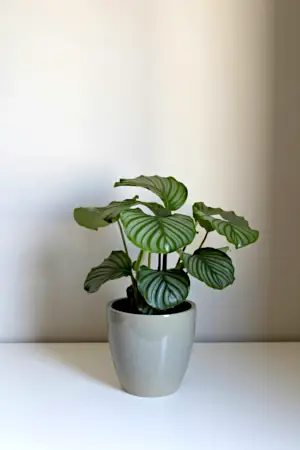
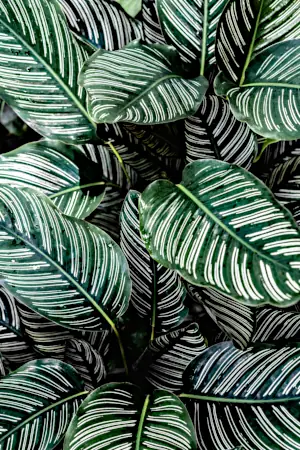
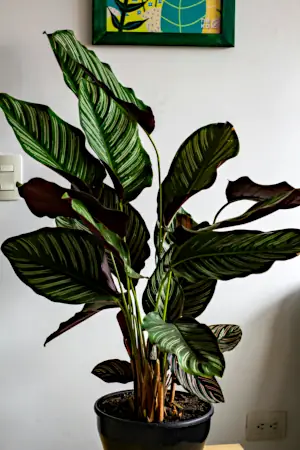
FAQs about Calathea Plant
Why are my calathea’s leaves curling?
Leaf curl usually signals low humidity or underwatering. Boost humidity with a pebble tray or humidifier and check that the soil isn’t dry.
Can I grow calatheas in low light?
Calatheas prefer bright, indirect light. While they can tolerate low light, their colors may fade, and growth may slow.
Is “calathey” a different plant?
No — “calathey” is a common misspelling of calathea. If you see this online, it almost always refers to the same tropical houseplant.
Final Thoughts on Calathea Plant
The calathea plant is more than just a pretty face — it’s a living piece of art that responds to its environment. With the right care, varieties like the calathea orbifolia, calathea white fusion, and rattle snake plant can thrive indoors. While they may require a little more care than the average houseplant, the payoff is lush, striking foliage that transforms your space.
If you’re ready to embrace the challenge, the calathea plant could become your new favorite indoor companion.
If you’re looking for a stunning contrast to the lush, patterned foliage of Calathea varieties, you might enjoy learning about the low-maintenance yet striking Snake Plant. Known for its upright leaves and air-purifying properties, the Snake Plant is another favorite among houseplant lovers. Explore our full guide on Snake Plant care here →

